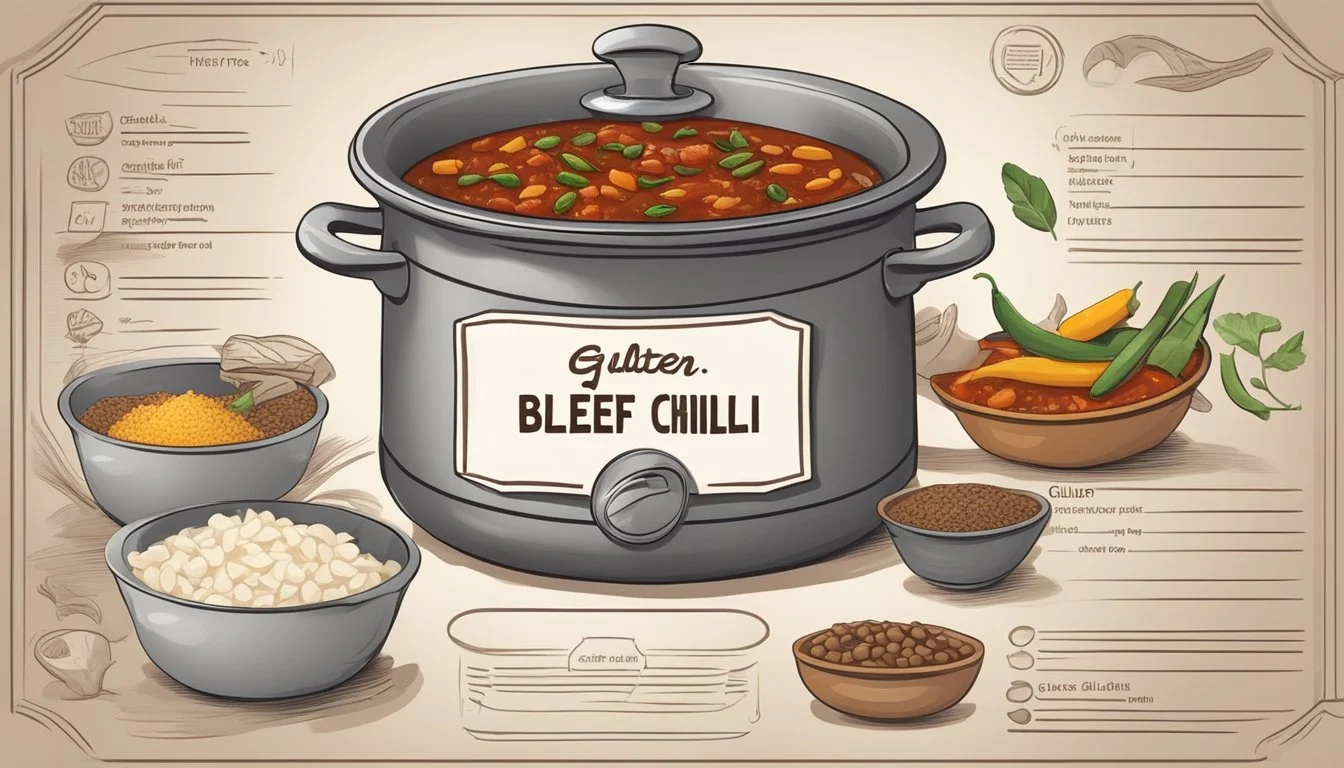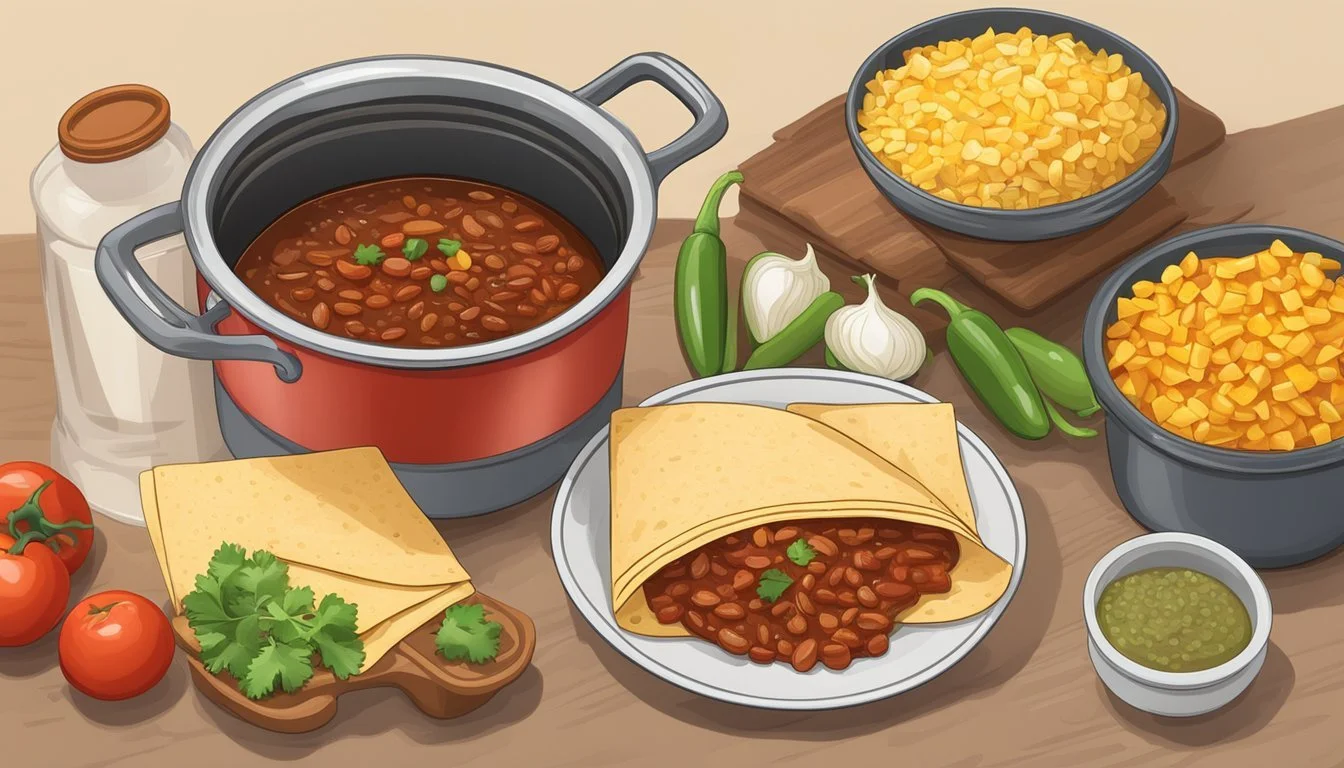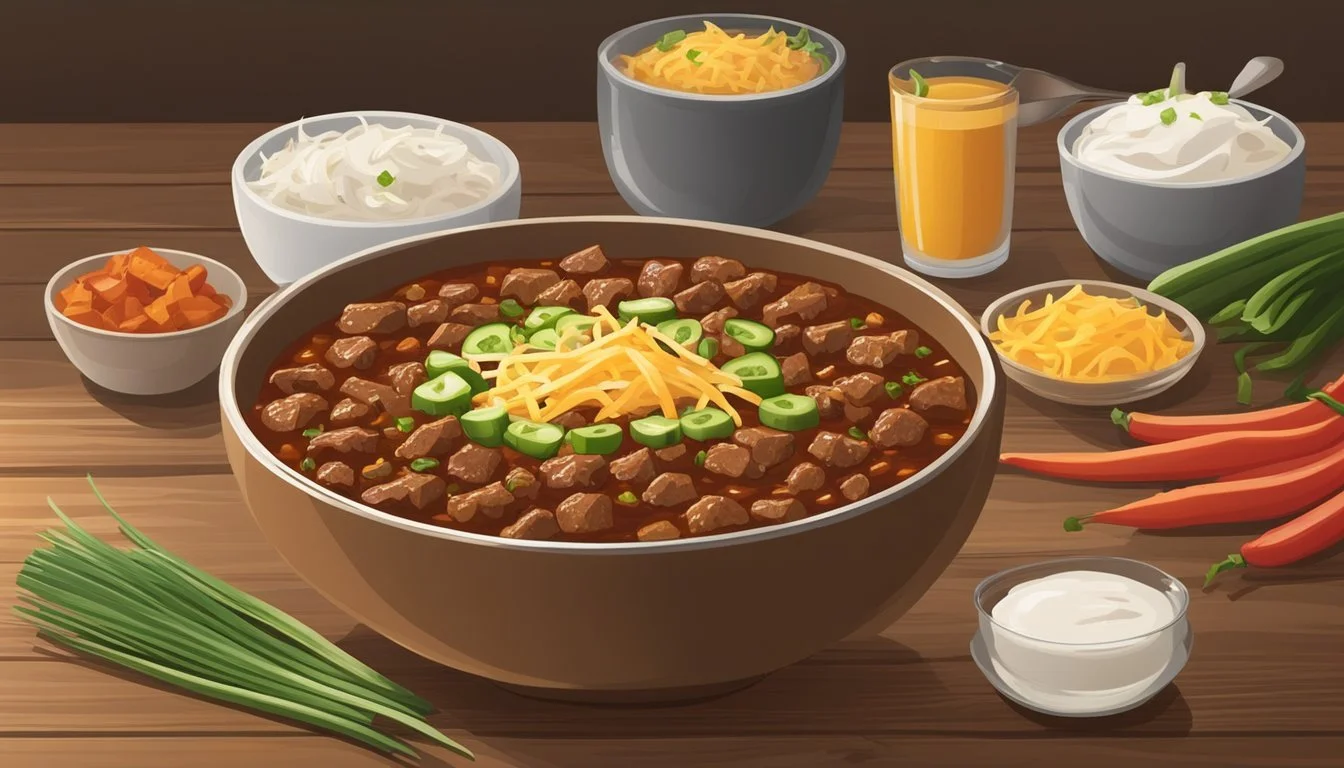Is Beef Chili Gluten-Free?
Unveiling the Truth About This Classic Dish
When considering whether beef chili is gluten-free, it's essential to understand the basic components of this hearty dish. Traditional beef chili typically includes ingredients such as ground beef, tomatoes, a variety of beans, onions, and a rich blend of spices. While these ingredients are naturally gluten-free, the dish's gluten status can be compromised depending on the preparation and additional components included.
The primary concern in determining if beef chili is gluten-free arises from the potential inclusion of gluten-containing thickeners, additives, or spices used during cooking. Store-bought chili powders or spice blends, which are staples in chili recipes, may contain gluten due to cross-contamination or additives like wheat flour, which is used to prevent caking. Moreover, commercially prepared chili, whether canned or served in a restaurant, may not adhere to gluten-free standards unless explicitly stated.
Those adhering to a gluten-free diet must exercise caution and thoroughly review ingredients when preparing or purchasing beef chili. Ensuring that all components, including the spices and flavorings, are certified gluten-free is crucial for maintaining a gluten-free diet without foregoing this flavorful and satisfying dish. Homemade chili offers the most control, allowing cooks to select safe ingredients and avoid the risk of gluten exposure.
Understanding Gluten and Chili
When assessing whether beef chili is gluten-free, one must consider the presence of gluten in ingredients and the traditional composition of a chili recipe. This section will explore what gluten is and the basics of preparing chili.
What Is Gluten?
Gluten is a group of proteins found in certain grains, such as wheat, barley, and rye. It's responsible for the elasticity and chewiness in the texture of grain-based products. For individuals with celiac disease or gluten sensitivity, ingesting gluten can lead to serious health concerns, necessitating a gluten-free diet. In cooking, gluten is often present in thickeners, sauces, and seasoning mixes, which can be components of chili recipes.
Chili Basics
Chili is a hearty stew that traditionally includes meats, beans, spices, and sometimes tomatoes. Beef chili, a classic variation, typically consists of ground or diced beef, kidney beans, and a rich blend of spices such as chili powder, cumin, garlic, and often a tomato base. While inherently many chili ingredients are gluten-free, cross-contact with gluten-containing products or the use of certain processed ingredients could compromise its gluten-free status. It's important to scrutinize each ingredient, including spices or packaged items, when preparing a gluten-free chili recipe.
When crafting an easy chili recipe, one can ensure it's gluten-free by selecting ingredients that are certified or labeled as such, and by being mindful of any additives that could contain gluten. Home cooking provides the best control when making a gluten free chili since it allows for the careful selection of all components involved.
Key Ingredients in Beef Chili
When crafting a beef chili, the quality and variety of ingredients are pivotal. They contribute to the richness of flavor and the texture of the final dish, with each component playing a specific role.
Examining Beef Options
The heart of beef chili is, unsurprisingly, the beef. For a robust flavor and satisfying texture, lean ground beef is frequently the cut of choice. It's important to brown the beef adequately, ensuring that it's thoroughly cooked before combining it with other ingredients. This step enhances the meat's flavor and texture in the final dish.
Beans and Their Varieties
Beans add both protein and fiber to beef chili, making it a hearty and nutritious dish. Popular choices include kidney beans, pinto beans, and black beans. They can be used separately or mixed together for varied texture and taste. Each variety of beans should be cooked to just the right tenderness to maintain individuality within the chili.
Red Kidney Beans: Often used for their robust structure and ability to hold up after long cooking periods.
Pinto Beans: Offer a creamy texture with a nutty flavor, adding complexity to the dish.
Black Beans: Contribute a slightly sweet undertone and are known for their rich, dark color.
Tomatoes and Their Forms
Tomatoes are essential for the iconic red base of the chili sauce. They come in multiple forms: diced tomatoes offer chunkiness, crushed tomatoes create a puree-like consistency, and tomato paste provides a deep, concentrated tomato flavor. Moreover, tomato sauce can be used to adjust the chili's texture and richness. Season these tomato components with spices such as cumin, chili powder, pepper, and salt to build layers of flavor. These elements must simmer together to allow a full marriage of flavors. Using a combination of tomato forms can enhance both the body and taste of the chili.
Preparation Techniques
When crafting a gluten-free beef chili, the success hinges on the cooking methods employed and the precise blend of seasoning mixes. Adherence to these two pillars ensures a flavorsome chili that's safely within gluten-free parameters.
Cooking Methods
Beef chili can be prepared using various cooking methods, each imparting its own texture and flavor to the dish. A traditional approach involves using a pot or dutch oven, which is ideal for achieving a well-simmered chili. One commences by browning the beef over medium heat, ensuring a rich flavor. The onions and cloves garlic are typically chopped and sautéed in the same pot, creating a foundational aroma for the chili.
Alternatively, a quick method employs the instant pot. This modern kitchen appliance significantly reduces cooking time while still delivering a deep, complex chili taste. After the initial sautéing steps, one adds the remaining ingredients to the instant pot, setting it to cook under pressure thus infusing the flavors rapidly.
Seasoning Mixes
The seasoning is pivotal to the identity of beef chili. A gluten-free chili seasoning blend usually includes:
Chili powder
Cumin
Garlic powder
Onion powder
One should meticulously verify that each seasoning is devoid of gluten-containing additives. Many store-bought seasoning mixes may come with gluten ingredients or cross-contamination risks, hence a homemade mix is often recommended for safety. The cook sprinkles these seasonings evenly over the cooked meat and vegetables, often adding a controlled amount of salt and pepper to intensify the taste. The addition of any toppings such as cheese or sour cream should also be scrutinous to ensure they meet gluten-free standards.
Gluten-Free Chili Considerations
When preparing gluten-free chili, it's crucial to scrutinize ingredients for hidden gluten sources and make informed substitutions, ensuring the dish remains safe for those with gluten sensitivities.
Identifying Gluten in Ingredients
Gluten, a protein found in wheat, barley, rye, and their derivatives, can often be present in items not typically associated with these grains. Key ingredients in chili, such as beans and spices, might be processed in facilities that also handle wheat, leading to cross-contamination. Therefore, individuals should read labels carefully to verify the gluten-free status. For example:
Beans: Kidney beans and other beans should be checked to ensure they are labeled gluten-free.
Spices: Pure spices like cumin, chili powder, oregano, paprika, and cayenne pepper are naturally gluten-free, but it's imperative to check for gluten-free labels due to potential cross-contamination during processing.
Condiments: Items like Worcestershire sauce may contain gluten. Opt for brands that specifically mark their product as gluten-free.
Thickeners: Some chili recipes use flour as a thickening agent; alternatives should be used in gluten-free chili.
Beer: Occasionally used in chili for depth of flavor, beer typically contains gluten. Gluten-free beer or a different gluten-free liquid should be substituted.
Alternatives and Substitutions
To ensure chili is safely gluten-free without compromising taste or texture, several substitutions can be employed:
Flour Alternative: Replace wheat flour with a gluten-free flour blend or cornstarch to achieve the desired thickness.
Gluten-Free Cornbread: Partner chili with gluten-free cornbread, ensuring to use gluten-free labeled ingredients.
Beer Substitute: Instead of traditional beer, use gluten-free beer or broth as an alternative liquid base for chili.
Homemade Spice Mixes: Crafting homemade spice blends can avoid the risk of cross-contamination found in pre-mixed spices.
By carefully selecting and substituting ingredients, anyone can enjoy a flavorful, comforting bowl of gluten-free chili.
Serving and Toppings
When serving beef chili, the dish can be elevated with the addition of toppings that blend well with the rich flavors. While the chili itself often carries a bold taste, the right toppings can add texture and freshness. It's important to choose gluten-free options if maintaining a strictly gluten-free diet.
Traditional Chili Toppings
Traditional toppings for chili include a variety of ingredients that add creaminess, crunch, and freshness. Here's a list of common chili toppings:
Sour Cream: A dollop can add a cool and creamy contrast.
Shredded Cheese: Cheddar or Monterey Jack adds a gooey topping that melts into the chili.
Sliced Green Onions: Their crisp bite gives a burst of fresh onion flavor.
Avocado: Creamy slices or a scoop of guacamole can provide a rich, buttery texture.
Cilantro: Fresh leaves can add a bright, herby note.
Gluten-Free Garnishing Options
Those with gluten sensitivities must ensure that their garnishing options are free from gluten-containing ingredients. Here are some safe gluten-free choices:
Gluten-Free Chips: Corn chips, tortilla chips, and Fritos are often gluten-free, but checking labels is crucial.
Sliced Jalapeños: These offer a spicy kick for those who enjoy heat.
Diced Tomatoes: Fresh or canned (without added pasta sauce), to add acidity and freshness.
Cheese: Opt for naturally gluten-free cheeses; avoid pre-shredded versions which may contain gluten as an anti-caking agent.
Always verify labels when selecting toppings to ensure they have not been exposed to gluten cross-contamination.
Storing and Reheating Chili
When it comes to keeping beef chili fresh and ready to enjoy, proper storage and reheating techniques are crucial. These practices ensure the safety and flavor of leftovers.
Best Practices for Storage
In the Refrigerator:
Store chili in an airtight container within two hours of cooking to prevent bacterial growth.
Chili should be kept in the refrigerator at 40°F or below and consumed within four days.
In the Freezer:
For longer storage, chili can be frozen in airtight containers or heavy-duty freezer bags.
Properly stored, chili will maintain its best quality in the freezer for up to three months.
Preventing Freezer Burn:
Make sure all air is removed from freezer bags to protect against freezer burn.
Label containers with the date to keep track of when it was stored.
Reheat Methodology
Stovetop Reheating in a Pot:
Transfer the chili to a pot and reheat on the stove over medium heat.
Stir occasionally until the chili is simmering and heated through evenly.
Microwave Reheating:
For a single serving, place the chili in a microwave-safe bowl and cover it with a microwave-safe lid.
Heat on high for two minutes, stir, and repeat if necessary until the desired temperature is achieved.
Instant Pot Reheating:
Utilize the "Sauté" function to reheat the chili, stirring frequently to ensure even heating.
If too thick, add broth or water to adjust the consistency.
Dutch Oven Method:
Reheat chili in a Dutch oven on the stove by setting it to a low to medium heat.
Cover with a lid, stirring occasionally, until fully reheated. Add broth if necessary to retain moisture.
Reheating with Toppings:
Reheat chili without toppings, and add them fresh after reheating to maintain texture and flavor.
One should always ensure the chili reaches an internal temperature of 165°F before serving, regardless of the reheating method used.
Nutritional Information
When assessing beef chili's nutritional value, it's important to consider its components, which typically include ground beef, beans, and a variety of vegetables. A gluten-free diet necessitates careful selection of ingredients to avoid gluten contamination.
Analyzing Chili's Nutrition
Chili made with ground beef is a substantial source of protein and iron, essential for muscle repair and oxygen transportation in the blood. Beans add to the chili's nutritional profile as they are rich in fiber and protein as well, while contributing minimal fat. Here's a basic breakdown of the macro-nutrient content per serving:
Protein: Essential for tissue repair and muscle growth
Fiber: Supports digestive health and can help regulate blood sugar levels
The addition of vegetables like onions, tomatoes, and peppers enhances the chili with vitamins and antioxidants without significantly raising the calorie count.
Gluten-Free Diet Benefits
A gluten-free diet excludes the protein gluten, found in grains such as wheat, barley, and rye. This diet is crucial for individuals with celiac disease or gluten sensitivity. For those requiring a gluten-free diet, it is important to ensure that all ingredients used in chili, particularly any thickening agents or additives, are devoid of gluten. The benefits include:
Digestive Comfort: Eliminating gluten can reduce symptoms for those with sensitivities.
Reduced Inflammation: For some individuals, a gluten-free diet may decrease inflammation.
When preparing gluten-free beef chili, one must ensure that all ingredients are labeled gluten-free, including spices and seasonings, to avoid cross-contamination.
Beyond the Bowl
When it comes to beef chili, there's more than just savoring the cozy meal from a bowl on a cold day. Chili enthusiasts can elevate their culinary experience with creative serving ideas and recipe expansions.
Creative Serving Ideas
A bold, spicy beef chili pairs delightfully with cornbread, offering a sweet and crumbly contrast to the robust flavors. For a twist on tradition, one might spoon their hearty chili over a thick slice of warm cornbread, creating a fusion of textures and tastes that's both filling and satisfying.
Chili also proves versatile when considering a crowd. For larger gatherings, it can be served as part of a "chili bar" where guests can top their chili with an array of fixings such as diced green bell pepper, jalapeno, minced garlic, creamy avocado, or even beans to cater to those who might prefer a bean-rich chili or a vegetarian option.
Expanding the Chili Recipe
Tweaking the classic beef chili can lead to exciting variations:
Tomato Base: Swap out tomato sauce for fire-roasted or canned tomatoes to incorporate a smoky depth.
Meat Variations: Trading beef for ground turkey can offer a lighter yet equally palatable option. The key to maintaining richness lies in browning the meat properly and allowing it to simmer with the chili powder and other spices.
Dairy-Free Options: To cater to a dairy-free diet, focus on the beans, spices, and tomatoes, which are inherently dairy-free, then garnish with dairy-free cheese or sour cream alternatives.
The goal is to maintain the essential character of a comforting bowl of chili while enhancing or adapting it to new forms and flavors. Whether opting for a quick and easy chili recipe with simple ingredients or an elaborate dish with a variety of ground meats and spices, chili remains a versatile cornerstone in both traditional and innovative American cooking.







